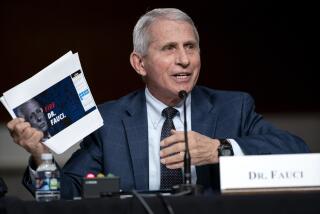Not the FBI’s proudest moment
The FBI’s investigation of the deadly 2001 anthrax attacks was the most complex and important in the bureau’s history. Immense resources were invested in the search for the perpetrator, whose actions killed five people, sickened 17 others, sowed panic in the immediate aftermath of 9/11 and caused taxpayers to spend extraordinary sums on a crash program to protect the nation against the danger of biological terrorism.
Yet for all that, the “Amerithrax” investigation, as the FBI dubbed the case, dragged on for seven years and, until quite recently, got nowhere. If Bruce E. Ivins, the Ft. Detrick, Md., microbiologist who died in an apparent suicide last week, was indeed the perpetrator, the prime suspect was directly under the FBI’s nose for years, practically sporting a scarlet “A” on his forehead. If he was not the perpetrator, as many of his fellow scientists at Ft. Detrick are insisting, we’re back at square one.
The investigation is sure to be scrutinized in depth by Congress, but its difficulties cannot be understood without a sense of the institutional context in which it began. The anthrax attacks came before the bureau at a moment when it was still quivering from a string of breathtaking debacles. On its website, the FBI celebrates its “top 10 moments.” These are not among them.
First, in September 2000, came the culmination of the Wen Ho Lee espionage case. All the charges against the Taiwan-born scientist, who had been accused of stealing the crown jewels of American nuclear secrets and passing them to China, were dropped that month, except one minor charge. An official Justice Department postmortem of the FBI’s investigation called it “deeply and fundamentally flawed” in “virtually every material respect.” It “suffered from neglect, faulty judgment, bad personnel choices, inept investigation and the inadequate supervision of that inept investigation,” among other things.
That grave embarrassment was followed only months later by the stunning revelation, in February 2001, that Robert P. Hanssen, the FBI agent in charge of Soviet/Russian counterintelligence, was a Russian mole. As far back as 1990, Hanssen’s brother-in-law, himself an FBI agent, had informed his superiors that Hanssen had a lot of unexplained extra cash on hand and of his belief that his in-law was spying for Moscow. At that juncture, the FBI could easily have apprehended Hanssen with some basic sleuthing. Instead, it did nothing except continue to promote him.
The internal shock over the Hanssen case had not worn off by 9/11. And only weeks later came news of the botched investigation of Zacarias Moussaoui, the Al Qaeda operative detained by the FBI in August 2001 while trying to learn how to fly a Boeing 747. After Moussaoui’s detention, FBI field agents tried frantically to obtain a warrant to look at the contents of his laptop. But supervisors in Washington found groundless reason after reason to balk, until the crashing of planes into New York’s World Trade Center and the Pentagon interrupted their reveries.
The Amerithrax investigation, vitally important for reasons obvious to all, was thus, from the FBI’s point of view, an opportunity to rehabilitate the bureau’s standing. With a great deal of publicity, it threw itself into the fray. Hundreds of thousands of hours were devoted to the investigation, and more than 9,100 people were interviewed, 6,000 subpoenas issued and 67 searches undertaken by “dedicated investigators who ... worked tirelessly on this case, day-in and day-out ... to go the extra mile,” according to the FBI.
But all to no avail. Drawing in part on a psychological-behavioral profile of the likely perpetrator, the FBI focused initially on Steven J. Hatfill, a biowarfare expert also at Ft. Detrick, named as a “person of interest” by former Atty. Gen. John Ashcroft back in 2002. But after hounding Hatfill for years, this probe proved to be a dead end. In June, Hatfill was effectively exonerated when he collected $5.8 million from the government to settle a suit contending that his privacy had been violated.
Only over the last year and a half did the bureau begin to focus on Ivins. Why it took the agency years to look in his direction is a central mystery. In late 2001, Ivins had been involved in an “accident” involving a spill of anthrax spores in his lab. He neither reported the breach nor reported his unauthorized cleanup. In 2003, Ivins showed up as a Red Cross volunteer to offer refreshments to investigators draining a Maryland pond in search of clues to implicate Hatfill; if he was indeed the perpetrator of the attacks, that’s like an arsonist watching firefighters extinguish a blaze that he himself set.
Most damning, according to the recent court testimony of his psychotherapist, Ivins had a decades-long history of making homicidal “threats, actions, plans.”
With every Ft. Detrick researcher on the list of suspects merely by virtue of their ready access to anthrax, it is baffling that the FBI missed any or all of this. The Justice Department has said it would release more information about the case later this week. Whether Ivins is conclusively shown to be the perpetrator, or whether he was an innocent man hounded by intrusive surveillance and public humiliation into suicide, questions about the FBI’s performance are piling up.
The bureau’s horrific track record before 9/11, and its single-minded focus on Hatfill after the anthrax attacks, raises the suspicion that, in the dramatic events of last week, we are glimpsing yet another monumental screw-up, one fully worthy of the FBI’s inglorious recent past.
More to Read
Sign up for Essential California
The most important California stories and recommendations in your inbox every morning.
You may occasionally receive promotional content from the Los Angeles Times.










